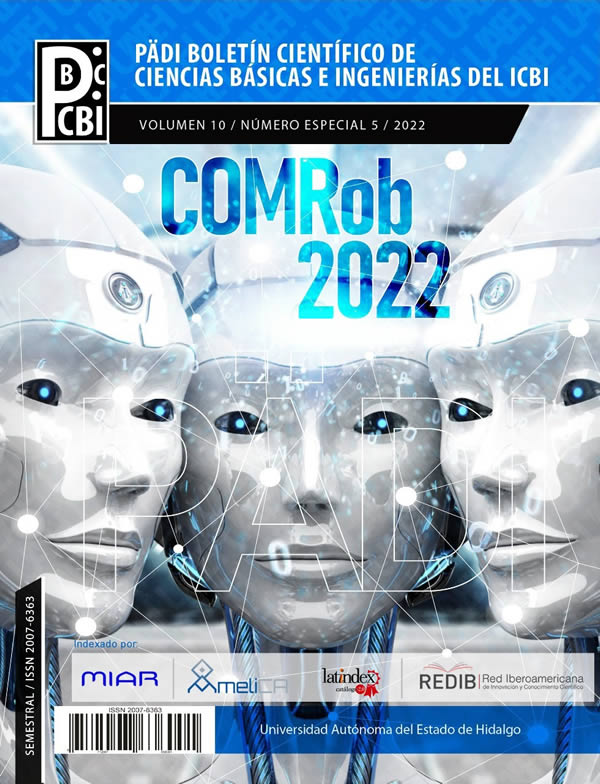Leader-follower scheme for unicycle-type mobile robots with mounted camera
Abstract
This paper describes a formation control proposal for unicycle-type mobile robots under the leader-follower scheme with mounted camera. The control objective is determined directly in image space, hence this proposal corresponds with the Image-Based Visual Servoing (IBVS) alternative. Using the Lyapunov stability theory, two controllers are designed: one that depends partially on the parameters of the vision system and another one that is robust to the three-dimensional parameters of the features that are mapped to the image space (the image features). Finally, experiments on a soft real-time platform with satisfactory results are carried out to validate the proposed theory.
Downloads
References
Antonelli, G., Arrichiello, F., Chiaverini, S. (2006). Experiments of formation control with collision avoidance using the null-space-based behavioral control. In: Proceedings of IEEE Mediterranean Conference on Control and Automation, Ancona, Italy. pp. 1-6.
Belta, C., Kumar, V. (2002). Trajectory design for formations of robots by kinetic energy shaping, Proceedings of IEEE International Conference on Robotics and Automation. Washington, USA. pp. 2593-2598.
Benhimane, S., Malis, E., Rives, P., Azinheira, J. R. (2005). Vision-based control for car platooning using homography decomposition. In: Proceedings of IEEE International Conference on Robotics and Automation. Barcelona, Spain. pp. 2161-2166.
Bugarin, E., Aguilar-Bustos, A. Y. (2014). Control visual para la formación de robots móviles tipo uniciclo bajo el esquema líder-seguidor. Ingeniería, Investigación y Tecnología. XV(4): 593-602.
Canudas de Wit, C., Siciliano, B., Bastin, G. (1996). Theory of Robot Control. Springer-Verlag, London, U.K.
Consolini, L., Morbidi, F., Prattichizzo, D., Tosques, M. (2006). On the Control of a Leader-Follower Formation of Nonholonomic Mobile Robots. In: Proceedings of the 45th IEEE Conference on Decision & Control. San Diego, CA, USA. pp. 5992-5997.
Das, A. K., Fierro, R., Kumar, V., Ostrowsky, J. P., Spletzer, J., Taylor, C. (2002). A vision-based formation control framework. IEEE Transaction on Robotics and Automation, 18(5):813-825.
Dani, A. P., Gans, N., Dixon, W. E. (2009). Position-Based Visual Servo Control of Leader-Follower Formation Using Image-Based Relative Pose and Relative Velocity Estimation. In: Proc. American Control Conference, St. Louis, MO, USA. pp. 5271-5276.
Dixon, W., Dawson, D., Zergeroglu, E., Behal, A. (2001). Nonlinear Control of wheeled mobile robots, Springer, London, U.K.
Guo, D., Wang, H., Chen, W., Liu, M., Xia, Z., Leang, K. (2017). A unified Leader-Follower Scheme for Mobile Robots with Uncalibrated On-board Camera. In: IEEE International Conference on Robotics and Automation. Singapore. pp. 3792-3797.
Hill, J., Park, W. T. (1979). Real time control of a robot with a mobile camera. In: 9th ISIR, Washington, D. C. pp. 233-246.
Hutchinson, S., Hager, G., Corke, P. (1996). A tutorial on visual servoing. IEEE Transactions on Robotics and Automation, 12(5): 651-670.
Khalil, H. (2001). Nonlinear systems, Prentice Hall, 3ed.
Kelly, R., Reyes, F. (2000). On vision systems identification with application to fixed camera robotics systems. International Journal of Imaging Systems and Technology, 11(3): 170-180.
Li, Z., Yuan, Y., Fan, K., Wei, H., Chun-Yi, S. (2019). Robust Vision-Based Tube Model Predictive Control of Multiple Mobile Robots for Leader-Follower Formation. In: IEEE Transactions on Industrial Electronics. pp. 1-10.
Liang, X., Wang, H., Liu, H., Chen, W., Liu, T. (2018). Formation Control of Nonholonomic Mobile Robots without Position and Velocity Measurements. In: IEEE Transactions on Robotics. 34(2) pp. 434-446.
Mariottini, G. L., Morbidi, F., Prattichizzo, D., Pappas, G. J., Daniilidis, K. (2007). Leader-Follower Formations: Uncalibrated Vision-Based Localization and Control. In Proc. IEEE Int. Conf. on Robotics and Automation. pp. 2403-2408.
Min, H. J., Drenner, A., Papanikolopoulos, N. (2009). Vision-based Leader-Follower Formations with Limited Information. In: IEEE International Conference on Robotics and Automation, Kobe, Japan. pp. 351-356.
Roberti, F., Toibero, J. M., Vassallo, R. F., Carelli, R. (2011). Control Estable de Formación Basado en Visión Omnidireccional para Robots Móviles No Holonómicos. Revista Iberoamericana de Automática e Informatica Industrial. 8(1): 29-37.
Shao, J., Xie, G., Yu, J., Wang, L. (2005). Leader-following formation control of multiple mobile robots. In: Proceedings of IEEE International Symposium on Intelligent Control, Limassol, Cyprus. pp. 808-813.
Soria, C. M., Carelli, R., Kelly, R., Ibarra, J. M. (2006). Coordinated control of mobile robots based on artificial vision. International Journal of Computers, Communications, and Control. 1(2):85-94.
Vidal, R., Shakernia, O., Sastry, S. (2003). Formation control of nonholonomic mobile robots with omnidirectional visual servoing and motion segmentation. In: Proc. IEEE Int. Conf. on Robotics and Automation, Taipei, China. pp. 584-589.
Wang, Y., Shan, M., Yue, Y., Wang, D. (2019). Vision-Based Flexible Leader-Follower Formation Tracking of Multiple Nonholonomic Mobile Robots in Unknown Obstacle Environments. In: IEEE Transactions on Control Systems Technology. pp.1-9.














